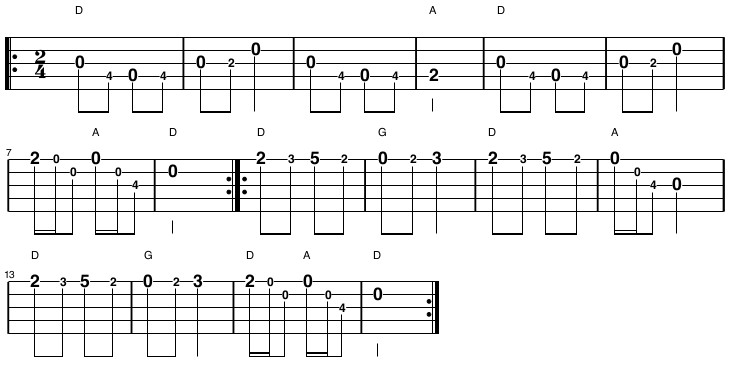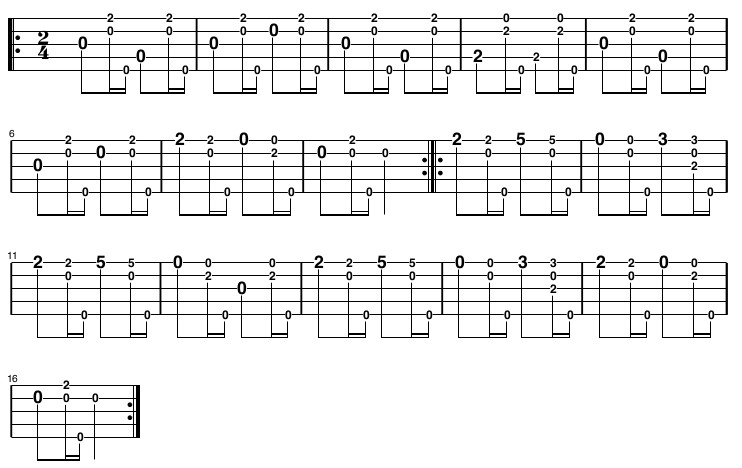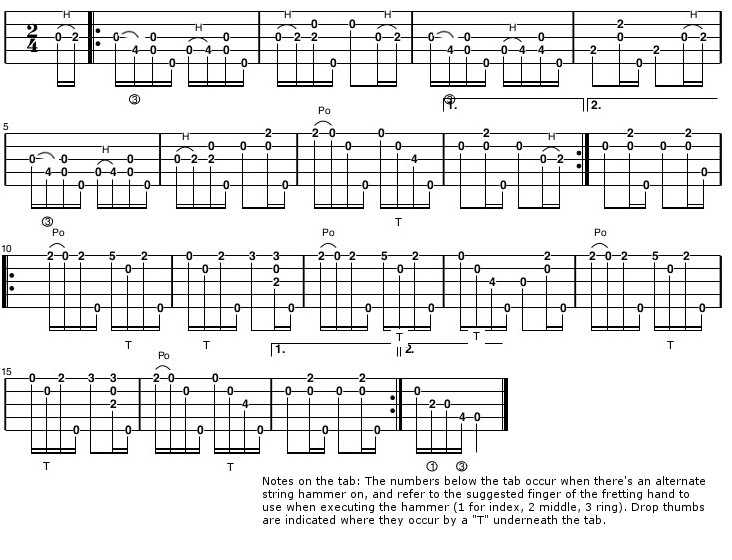Episode 1: Soldier’s Joy
And for good reason. It’s one heck of a great tune. Many an unsuspecting Scruggsophile has been seduced to the drop thumbing dark side by its call, myself included.
Now, I’ve heard it said before that Soldier’s Joy is not a suitable tune for a beginner, that it’s too complicated or technically demanding. I’ve also heard it said that gerbils don’t bite, but scars don’t lie.
So let’s put that myth to rest. There is nothing inherently hard or easy about a tune. Yes, a particular arrangement of a tune can be technically challenging, but how you choose to arrange a tune is entirely up to you.
For the most part, you’re free to make a tune as technically demanding as you wish. This applies especially in a jam setting, where the fiddle is typically responsible for making sure the melody is rendered with appropriate fanciness.
Our Standard Procedure
In this Core Repertoire Series, every tune will be first broken down into its skeletal melody. What you’ll find as we do this is that, stripped of their ornamentations and fanciful flourishes, all these tunes look about the same naked. Which is to say quite good, thank you very much.
Once you’ve identified it’s soul, you can then dress the tune up however you wish, and how fancy you make it is what really determines how technically demanding it is.
This method of building each tune from the ground up is one we’ll use for each of the tunes in the Clawhammer Core Repertoire Series, and its an approach I suggest you familiarize yourself with. By stripping each tune down to its core and then building it back up again, you’ll not only find the process of learning new tunes much more accessible, you’ll also inevitably begin adding your own stylistic preferences into your playing. And you’ll be much closer to being able to make good music with other people. ‘Nuff said, it’s tune learnin’ time.
Step 1: Know thy Melody
First, you must listen. It is a cardinal sin of banjo learning, punishable by up to five consecutive nights at a singer-songwriter open mic night, to attempt to learn any tune before you have burned its melody into your cerebral circuits.
This steadfast directive applies whether you are learning by tab, ear, cablecar, vestigial appendage, or some combination thereof. You should always be capable of humming the melody from start to finish before you ever start trying to learn it on your instrument. No cheatin’.
And, again, what we’re really interested in here is finding the tune’s essence. Rarely do two musicians play any particular tune the same exact way; however, the core melody is always there.
Individual musicians may decorate the tune’s skeleton in different ways, but its essence doesn’t change. For if it did, it would be a different tune.
It’s analogous to the difference between you and your appearance at any given time: though your hair and clothes may vary from one day to the next, your friends and family still know its you. They can easily identify your essence underneath the fedoras and cardigans.
It stands to reason that the best place to learn how a fiddle tune goes is to hear it played on the fiddle. So let’s begin by listening to a few versions of Soldier’s Joy on the fiddle courtesy of the fiddle hangout (if you’re wanting to play music with others, I suggest you get in the habit of learning new tunes from instruments other than the banjo, which is why we won’t be using banjo recordings in this series).
Example 1
Example 2
Example 3
Example 4
While it’s clear in each of these examples that the same tune is being played, no two versions sound the same. The notes, the phrasing, the rhythm is different in each and every one; however, you can still easily tell each one is Soldier’s Joy. Why? Because the core of the tune, which you identify naturally, is always there.
And it’s that core of the tune that you must first know cold before proceeding further. So don’t move to the next step until you can hum that essence to yourself.
Step 2: Find the melody notes
For the next step, let’s take out our banjos. Soldier’s Joy is in the key of D, so tune your banjo to aDADE (aka “double D” tuning). It’s time now to see if you can pick out the basic skeletal melody of Soldier’s Joy. Don’t add any rhythmic or melodic embellishments at this point. Just find the basic melody notes. It should sound something like this:
And here it is in tablature form (chords are listed above the tablature):
Step 3: Add some clawhammery stuff
Now, in the basic bum-ditty pattern of clawhammer banjo, the striking finger of the picking hand (be it your index or middle) is almost always going to be striking a single string on the downbeats of each measure (i.e. the “bums” always occur on a downbeat). For your convenience, the notes that occur on the downbeat are represented in a larger font in the tab above.
To create a simple, but entirely adequate, arrangement for clawhammer banjo, just play those melody notes that occur on the downbeats of each measure, and then play a “ditty” stroke after them. In tab form, it looks like this:
And sounds like this:
Already, we have a respectable version of Soldier’s Joy for clawhammer banjo that would work just fine in a jam context. Also, since it’s constructed from the essence of the tune, it should also mesh just fine with many different fiddle arrangements. Here’s what it sounds like played alongside the fiddle:
And from the perspective of the fiddler (me in this particular case), this particular arrangement is perfectly good. Fiddlers mainly care about one thing when it comes to banjo players – that they keep a solid rhythm.
Most couldn’t care less how many drop thumbs or alternate string pull-offs you manage, so long as you keep a steady beat and play your notes in time. So keep this in mind any time you’re trying to spruce up a tune. Never sacrifice your rhythm and timing for the sake of a fancier arrangement.
Step 4: Embellish to fit the situation
Now that you have a basic clawhammer version of Soldier’s Joy pared down to its essential core, you’re free to adorn it as you please. You could, of course, start adding in some extra stuff to flesh out a version that sounds good on solo banjo.
However, since this series is about getting you playing with others, I encourage you to start thinking like a musician in an ensemble. Remember, what sounds good as a solo arrangement may not work so well in the context of a group, so it’s a good idea to start getting into the habit of learning how to adapt your playing to suit the situation and enhance the overall sound.
One of the best ways to adapt a tune to fit a jam situation is to try to match the arrangement and phrasing of the fiddler, since the banjo and fiddle playing in tandem is one of the most wondrous sounds in old-time music. Let’s try that with the fiddle version we just heard. First, listen to it again solo:
Now here’s how that particular arrangement and phrasing of Soldier’s Joy sounds translated to clawhammer banjo. Again, I’m trying to capture as many of the nuances of the fiddle part without sacrificing the rhythm.
And here’s how that arrangement looks in tab:
Played with the fiddle, here’s how the two sound together:
Neat stuff, right?
Step 5: Practice smart
I’ve said it before, but it bears repeating: the best way to practice jamming is to practice jamming. So, as you continue to work on getting this tune under your fingers, I encourage you to head over to oldtimejam.com and make use of the Soldier’s Joy backup tracks, which are the next best thing to practicing with living creatures.
Start first with the slow guitar backup tracks. Once you can play along with that, move to the regular speed backup track. Once you have that mastered, then try playing along with the “fiddle and guitar” track to get the hang of playing it alongside the fiddle.
See if you can adapt the way you play it to fit in the groove and double the fiddle as best you can. For extra credit, go back to those fiddle versions I linked to earlier and see if you can adapt your playing to fit well with them as well.
Whatever you do, don’t ever stop playing this tune. It’s number one for a reason, and deserves to be spread to the far reaches of the galaxy.
And beyond.


